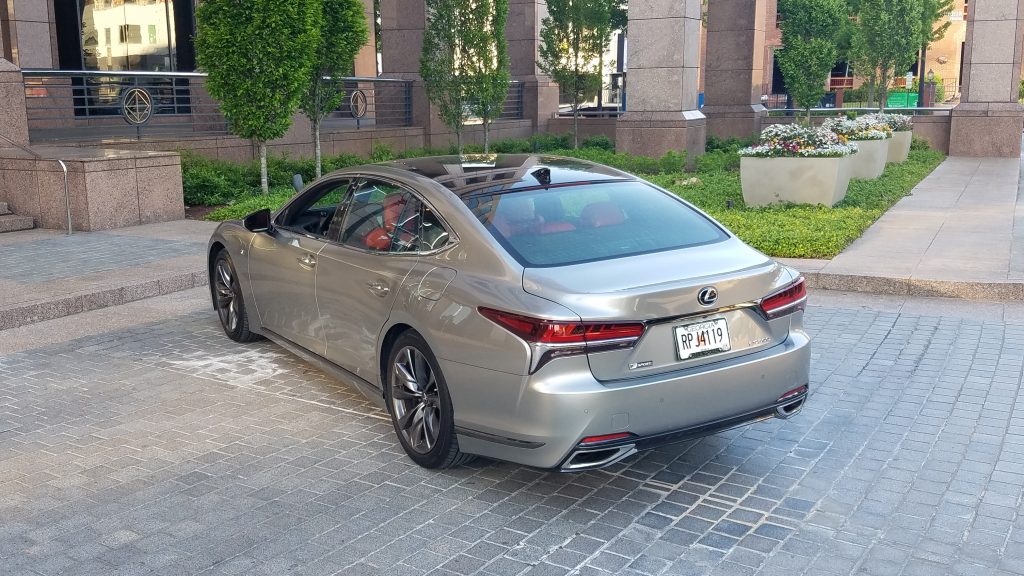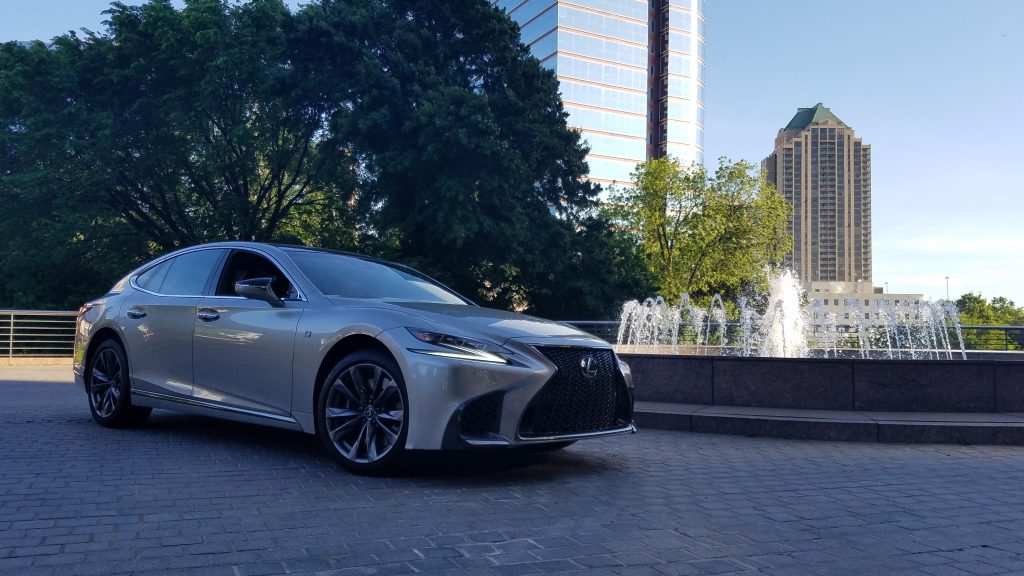
Highlight: The LS is only available with a 6-cylinder engine.
Test Vehicle’s MSRP: $101,905 (Base model: $76,325)
Seating Capacity: 4 or 5 (depending upon trim)
Standard Safety Features: ABS; airbags; a back up camera; heated dimming exterior mirrors; a tire pressure monitoring system; a pre-collision system; a radar activated cruise control system; a lane departure alert system with a lane keep assist; an automatic high beam automatic headlamp system; blind spot electronic mirrors; a rear traffic cross alert system; a pre-collision braking system; a parking assist system with an auto-stop system; stability control system; and rain-sensitive windshield wipers
Standard LS 500 Equipment: 19-inch wheels; a 10-speed automatic transmission; a push button ignition system; a heated leather steering wheel; steering wheel paddle shifters; power front seats; a rear seat power control mechanism to control the from passenger seat; power front headrests; leather seats; a dual zone automatic climate control system; a power rear sunshade; leather trimmed assist grips; ambient airplane-like interior lighting; a power moonroof; 4- illuminated visor vanity mirrors; a variety of driving modes; a navigation system; in-vehicle Wi-Fi; a 12-inch infotainment screen; a hands free open and close trunk with a kick feature; an automatic soft touch door closer; a remote touchpad; memory feature settings for both front seat occupants; and access fuel updates, sports and stock picks
Standard F-Sport Equipment: 20-inch wheels; darkened chrome lower trim; dark Graphite finish; larger front brakes; and larger rear brakes; bolstered sport front seats; an ergonomic steering wheel trimmed in leather; and Lexus’ LFA-inspired instrumentation
Options On Review Vehicle: 20-inch wheels; pre-collision active braking; active steering assist; pedestrian alert; front cross traffic alert; and a lane change assist system; adaptive variable air suspension with a rapid height adjustment; a windshield wiper de-icer; headlamp washer; enhanced interior heater; a heads up display system; a 23-speaker Mark Levinson audio system; mesh grille inserts; a rear diffuser; ultra-suede headliner; aluminum pedals; variable gear ratio steering; active rear steering; active stabilizer; a panoramic glass roof; panoramic view monitor; and a F-sport leather heated steering wheel
Other Trim Level: a hybrid
Standard Audio On Test Vehicle: a 12-speaker AM/FM/CD/HD satellite radio
Apple CarPlay/Android: Only Apple CarPlay
Bluetooth Connectivity: Yes
USB Connectivity: Yes
Bumper-to-Bumper Warranty: 4 years or 50,000 miles
Powertrain Warranty: 6 years or 70,000 miles
Standard Engine/Horsepower: 3.5-liter, 6-cylinder/416-hp
Recommended Fuel: Premium
Standard Fuel Mileage: 19-city/30-hwy

What’s New: The current generation LS was overhauled during the 2018 model year. The brand’s fifth generation LS continues to push the envelope in terms of styling, technology, luxury accoutrements and fuel-efficiency. The LS 460 now wears the name LS 500 due to its new engine and transmission.
For the 2019 model year, the LS is now outfitted with both Amazon Alexa and Apple CarPlay. The brand’s curvaceous styled flagship sedan is available in a rear wheel drive or an all-wheel drive configuration. The fifth generation luxury sedan is available in a base trim and a sportier performance-oriented F-Series.
In reimaging this big body Lexus, the brand borrowed exterior design styling cues from Porsche’s Panamera, with its new curvaceous fastback rear roofline. For Lexus, this is a break from the traditional stodgy styling one usually attaches to today’s stately flagship sedans.
Like Porsche, Lexus has made great strides to push the LS, or more specifically, the F-Sport, toward being a performance luxury vehicle, with its lower profile, after lowering the hood and trunk approximately 1.2 inches and 1.6 inches, respectively. Ironically, due to the lower profile, the brand’s flagship is available with an optional air suspension system, which raises the vehicle, making it easier for occupants to enter and exit (being that the previous model literally appealed to older buyers). We also found that Lexus’ bold signature grille seems more fitting for this generation’s LS, as opposed to the previous model.
Lexus has also literally pushed the luxury envelope for those who prefer to be chauffeured with this new sedan.
For instance, this year’s optional Executive Package adds two passenger side seats that can recline up to 48 degrees. With the reclining seats, buyers can enhance the comfort with optional heated and massaging seats. Optional 20-inch chrome wheels are also available with this package.
Moreover, an optional rear seat touchscreen control, allows rear seat occupants the ability to adjust both the ventilation and massage settings, is another feature to consider for executives.
The flagship vehicle has also stepped up its aesthetics game, too. An optional Kiriko glass interior door trim, which is designed by hand, catches the eye and light. Each piece of glass requires up to 147 points of polishing. This is just an extra touch Lexus has added to amplify the experience of being chauffeured.
And as Tesla and other makes are moving forward with self-driving vehicles, the all-new LS is finally joining the self-driving movement too, with its co-pilot assist steering system. Just like Volvo, the LS requires one to gently keep their hands on the steering wheel, when the system is activated. The system is not as advanced as Cadillac’s Super Cruise, which allows one to drive in most instances, without keeping their hands on the steering wheel. However, unlike its competitors, the LS optional Lexus Safety System plus system includes an all-speed radar-activated cruise control system, combined with Lane Trace Assist.
Lane Trace Assist provides steering support on a highway. In instances, where line markers on the road are somewhat sketchy, the Lane Trace Assist system traces the path of the vehicle ahead of it. The system can also aids on more dynamic roads, if the speed at which a Lane Trace Assist-equipped vehicle entering a curve is deemed to be too fast, the driver’s speed will be altered by way of the vehicle’s heads up display (HUD) and the multi-information display systems, automatically slowing down the LS.
Furthermore, when the radar activated cruise control system is activated, the Lane Change Assist system determines if it is safe to change lanes and steer the vehicle into the next lane, if it is clear to do such. All of these systems working together collectively makes driving less stressful.
Lastly, in order to accommodate all of the new safety driving aids, the all-new LS is now powered by a new 10-speed automatic transmission. The fuel-efficient transmission is matted to a 3.5-liter, twin-turbo 6-cylinder engine. The previous generation LS was powered by a 4.6-liter, 8-cylinder engine, which only pushed out 386-horsepower. With the new twin-turbo engine and new transmission, traditional V8 buyers won’t miss a beat.
But: One of the continuous complaints with Lexus is that the design engineering team should consider adding dials and knobs to the infotainment system. The remote touch pad, which is designed, to operate the ventilation and audio system seemed to be overly sensitive.
In fact, we had difficulty cancelling the directions we requested from the voice activated navigation system and turning off the ventilated driver’s seat. As a side note, after a few days, we finally got the magic touch, prodding the touch pad to turn off the ventilated driver’s seat. Buttons and knobs (and possibly a touchscreen system) could have resolved this issue. Unfortunately, the engineering team for the LS didn’t design a touchscreen system.
Also the LS should borrow a feature from BMW, which allows one to lock all of the doors from a switch which is located on the power trunk.
Moreover, like all Toyota and Lexus models, the LS audio system is not compatible with Android smartphones.
Lastly, for buyers seeking an 8-cylinder engine, a wireless charging pad and an automatic perpendicular/parallel parking system, they’ll have to defer to their competitors.

Verdict: As car buyers shift toward luxury trucks, SUVs and crossovers, the big body LS continues to set a standard for what a dream vehicle should be despite consumers shift in the market. With the bold red leather seats, the technological enhancements, the more fuel-efficient engine and the Panamera-like exterior design in the LS-F we reviewed, Lexus’ breakout flagship sedan is virtually a hit in our eyes. Overall the Japanese brand continues to push the envelope, with the new LS in terms of building and designing world class vehicles. As always, the LS continues to be a great road vehicle that easily absorbs imperfections in the road. Added to that, the new co-pilot assist steering system makes driving stress-free.
Competition: Audi A8; BMW 7-Series; Genesis G80; Kia K900; Jaguar XJ; Mercedes-Benz S-Class; and Porsche Panamera
More Info About JeffCars.com: For a new-car pricing configurator, used car buying tips, recall updates, a car-payment calculator and air times to tune in to SiriusXM’s Auto Trends with JeffCars.com, cruise over to JeffCars.com.
We Publish News 24/7. Don’t Miss A Story. Click HERE to SUBSCRIBE to Our Newsletter Now!





